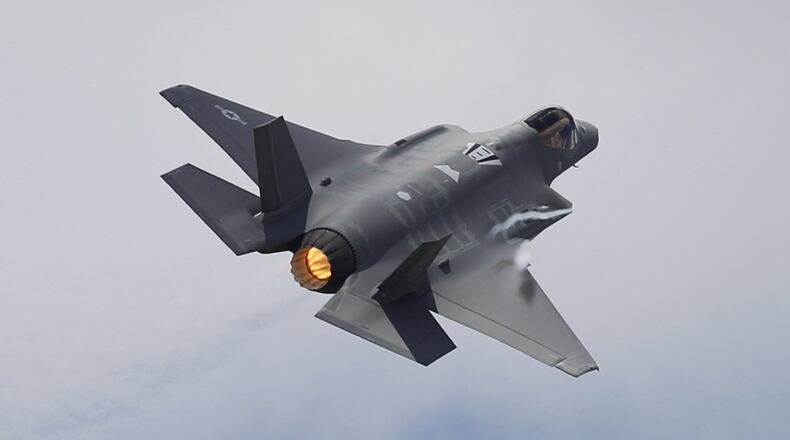The Pentagon agrees with a Defense Department report to dissolve the joint program office and turn over oversight to each individual branch based on the version of the aircraft that it flies, a spokesman said.
The recommendation “directly supports” one of Defense Secretary James Mattis’ top priorities to reform “the way we do business,” Pentagon spokesman Cmdr. Patrick Evans said in an email.
RELATED: Wright-Patterson to get new base commander
The Defense Department will come up with a detailed plan with specific transition dates over the next year.
“The hope is that we get that win and we bring it to the current structure at Wright-Patterson,” said U.S. Rep. Warren Davidson, R-Troy. “I think it would be a nice win for the Dayton region, for Wright-Patterson to bring it here.” He didn’t rule out a potential role for Springfield Air National Guard Base, also.
The Air Force flies the F-35A, a land-based variant. The Navy and Marine Corps would have a joint office to oversee the Marines’ F-35B. a vertical take-off and landing version, and the Navy’s the F-35C, a carrier-based jet which has not yet deployed to squadrons.
RELATED: Top AF leader: Wright-Patt looking for cause of F-35 problems
Wright-Patterson is home to the Fighters and Bombers Directorate with offices for front line programs, such as the F-15, F-16, F-22, B-1, B-2 and B-52. An F-35 division office at the base oversees technological development of the fighter.
U.S. Rep. Mike Turner, R-Dayton, said Wright-Patterson should “bode well” in the competition for the Air Force program to manage the future of the F-35.
“There’s a couple of reasons why I think we bode well in this,” said Turner, chairman of the House Tactical Air and Land Forces Subcommittee.
“One, we have the dedicated and experienced workforce that can easily shift to the F-35 work.”
RELATED: What are the myths of the Memphis Belle? Air Force museum to tell all
Secondly, he said, the base has a large international contingent and offices for foreign military sales “and no other base in the running has that.”
Wright-Patterson has “the long legacy of our history of working on advanced aircraft,” and a close proximity to Washington, D.C., Turner added.
“It will provide an easy transition if it comes to Dayton, Ohio,” he said.
The number of bases under consideration wasn’t released.
Daniel Grazier, a defense analyst with the non-partisan watchdog Project On Government Oversight, said it’s probably a good idea to let each service branch have oversight.
“I’ll be interested to see how it works in practice,” he said. “In theory, it’s probably a good idea because a lot of the problems with the F-35 program already are the direct result of it being a joint program.”
RELATED: Air Force Marathon director leaves
Grazier said it would have been a better decision to separate the service programs in the late 1990s, prior to the initial development contract in October 2001.
The Pentagon had forgotten the lessons of an earlier 1960s-era program, the F-111, when plans were scrapped for a joint fighter between the Air Force and Navy, he said. The Air Force flew the jet without the Navy buying its own version because of a wide gap in requirements.
“It’s always problematic,” he said. “This has been tried before and it didn’t work out all that well.
“We scrapped all of those lessons and went right back to the F-111 model so we have to learn all of these lessons again the hard way.”
Grazier said the F-35 has the added issue of heavy reliance on defense contractors to stay operational.
Sustainment costs could reduce the number of F-35s the Air Force buys.
RELATED: Spending plan could give boost to Wright-Patt
The Air Force must lower the cost of the F-35 or risks cutting up to a third – or 590 out of 1,763 planned purchases — if it doesn’t reduce expenses by 38 percent over a decade, an internal Pentagon document indicated, according to Bloomberg News.
The purchase of 2,456 of the stealth jets will cost about $400 billion based on current projections. Flying and maintaining the aircraft through 2070 could cost as much as $1.1 trillion, according to a Pentagon estimate.
PREVIOUSLY: The Pentagon has managed development of the F-35 Joint Strike Fighter for three service branches in a single office in Crystal City, Va.
WHAT'S NEW: The Defense Department has recommended management of the F-35 program into an office for the Air Force and a separate office for the Navy and Marine Corps.
WHAT'S NEXT: Two congressional leaders say Wright-Patterson is contention to manage the Air Force version of the program.
About the Author
